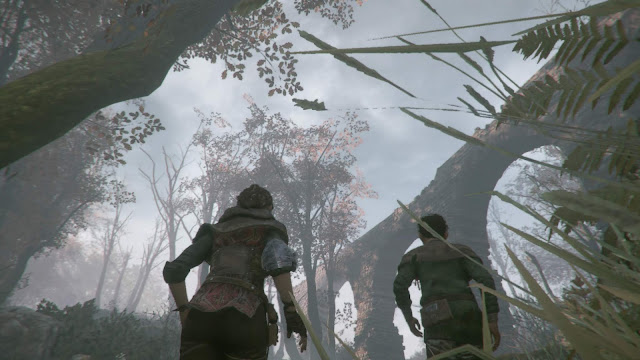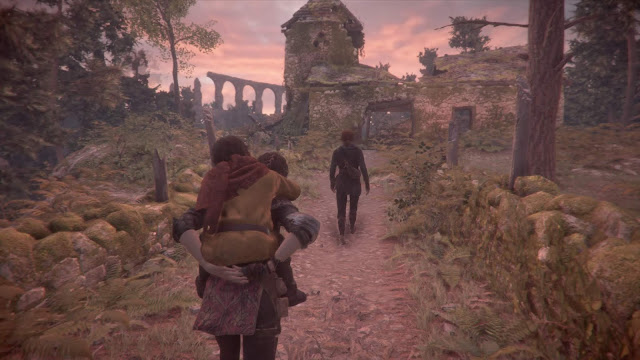Review by Matt S.
A Plague Tale: Innocence is a game of two parts. One is its narrative, and Innocence tells an absolutely cracking narrative. In it, 14 year-old Amicia and her little brother struggle to survive the perfect storm of the Black Death, the Inquisition, and the Hundred Years War brought together, all chasing the two of them, and all at once. Yes, for anyone wondering, all three of these historical horrors really did happen at the same time, and it was not a good time to be alive, let alone if you’re a 14-year old that suddenly finds herself in the role of guardian.
The second part is the gameplay, which is so far divorced of the narrative that the Inquisition would come after it. In playing A Plague Tale, at just about every stage it’s difficult to shake the feeling that the developers lacked the confidence in the story that they were weaving, because they kept trying to shove irritatingly inappropriate gameplay elements to distract us from the story that it’s telling. Too many developers do that.
But first, the good. Amicia is a brilliant protagonist for A Plague Tale. A short introductory chapter establishes her as a rather sweet and innocent, naive girl. She’s not the princess type, thankfully. Rather, she’s a tomboy in that she does enjoy hunting with her father and her dog, so the game avoids the tropsey setup that you might have expected going in. Nonetheless, Amicia is dressed elegantly and blissfully spends her time separate from the layered nightmares of life in the world outside of her family’s property.
Sadly that doesn’t last long, and Amicia soon finds herself entirely responsible for her kid brother’s survival, as the two of them embark on a road trip to escape both the Inquisition and the Plague. Armed with nothing but a sling, and needing to deal with a sheltered boy’s occasional tantrums, Amicia is forced to grow up, and fast.
It’s an affecting tale, precisely because it is one of innocence lost. Amicia is used to people being open and friendly. The first people that she encounters in the first, Plague-affected, village that the two turn to for help, are violent thugs who are burning living victims of the disease. They then come after her and her brother because they might be carrying it themselves. Amicia then kills someone for the first time. Later she and her brother have to pick their way through the remnants of a battlefield, while trying to avoid the looters and soldiers picking over the dead bodies. Then she’s captured and her captors torment her by making it explicitly clear what kind of slavery she’s about to be sold into.
A Plague Tale doesn’t show a great deal of restraint in how it presents the horrors of the time. The Black Death is depicted not as a creeping disease that slowly eats away at entire communities. but rather as endless swarms of rabid rats. The (relatively) slow progress of death to the actual plague is much less visually appropriate for an action game as a swarm of biting, aggressive rats, so it’s hard to begrudge the developers that indulgence. Slightly less forgivable is the almost comically unsubtle way it handles the juxtaposition of the horrors of humanity (looters, soldiers, Inquisition and terrified-to-point-of-homicidal villagers) with the threat of the rats and Plague. In fact, the narrative outright throws up the question “the rats are forgivable because they’re an unthinking swarm… but are humans even worse?” That is a pertinent question to ask and certainly A Plague Tale asks it in a robust manner, but it’s truly sad that video game writers need to be so overt with every theme they explore as to literally spell it out for players. Whatever happened to ‘show, don’t tell’ as the foundational philosophy of good creative writing? An audience whose understanding of subtlety is Fortnite, I guess.
Nonetheless, I found myself completely absorbed in Amicia’s plight, and both she and her brother are characterised beautifully. There’s plenty of sweet little interactions between them in the rare moments that they’re safe, but it’s the way they can get into a heated argument, only to immediately forgive each other, that really nails the sibling dynamic. The voice acting, too, is a cut above what I would have expected for a B-tier video game, and to put it into context, the narrative and presentational quality of A Plague Tale elevates it to sit around Hellblade as the pinnacle of what a game outside of the “AAA-blockbuster” industry can look, sound, and feel like. I cared, deeply, about what was going on in this game, and that’s entirely because of the narrative.
Unfortunately the gameplay of A Plague Tale constantly undermines the narrative, and as much as I hate using the term “ludonarrative dissonance,” it applies to A Plague Tale, and ultimately undermines its quality as a game. Amicia is depicted as shellshocked the first time she kills a man. Not a day later she’s stealth killing her way through stealth sections with such efficiency that Ubisoft might want to have her star in an Assassin’s Creed tie-in game. To make matters worse, an anime version of Amicia could star in one of Koei Tecmo’s Atelier titles, because as Amicia learns alchemical tricks, she ends up with more ways to use pocket lint than MacGyver. When she learned how to make fire bombs – her first ‘trick’ – it was one thing, because that made sense within the fiction. She needed fire to keep the rats away, and fire missiles are as easy to create as putting some material into a bottle of alcohol – both of which are believable as readily available materials even in the middle of war and Plague-ravaged France.
It’s when Amicia starts creating potions that have the magical ability to force soldiers to take their helmets off (so she can then cave their skulls in with her slingshot), that A Plague Tale started to lose me. Amicia is a resourceful girl, sure, but being able to distract guards by throwing rocks at metal objects is what an resourceful girl would actually be doing. Brewing magical “helmet-take-off” potions, or able to cocktail up some chlorophyll on the fly to knock out guards cold, is shattering the suspension of disbelief I want to take for the character entirely.
As gameplay elements, all these new tricks and potions that Amicia learns has allowed the developers to keep finding new ways of challenging the player, but it has come at the cost of cohesion within the narrative. I would have rather A Plague Tale be built around a smaller range of tricks, but with gameplay and cut scenes versions of Amicia being in better alignment. The same goes for the crafting system. I know that conventional game design wisdom tells us that modern adventure games need crafting systems, but when I’m watching a little girl help her even littler brother climb over a pile of bodies that are rotting in a swampland, so they can avoid being captured, raped, and ransomed off to the Inquisition, the last thing the game’s atmosphere needs is for me to then take a detour over to a conveniently-placed treasure chest, filled with ropes, strips of leather, papers and other ingredients, so I can upgrade my slingshot so that it shoots faster.
It’s hard to outright blame the developer here. Game developers do struggle to ensure that all the gameplay elements in their project properly match with the type of narrative being told, and there are certainly much bigger game projects, run by much larger and more cashed-up development teams, that do much more to ruin their narratives with arbitrary crafting systems than what we see in A Plague Tale. But then I’m rarely so invested in a narrative or setting as I was with this one, so the poor implementation of gamey elements, just to make sure that no one would accuse the game of being a “walking simulator,” is all the more disappointing.
On the plus side, mechanically, the stealth sections are quite nicely designed. There’s a clean flow through environments, and more importantly, the tall grasses that grant invisibility when Amicia and her brother crouch down in them, are placed in believable locations throughout environments. The enemies themselves are also far better placed than we see in many stealth games. The game is filled with great moments like a sequence where you need to stealth your way through an army’s mess hall, or distract a guard by tossing a rock at a nearby scarecrow so you can direct Amicia’s little brother through a tiny hole in a dilapidated building. From there he opens a window and you can follow him through the building and to safety. Guards have such believable and authentic AI and sight radars that rather than artificially increase their speed and health to provide a “hard mode,” A Plague Tale does it by removing the HUD completely, forcing you to pay more attention to your surroundings. It shows real confidence in the stealth system on the part of the developers that they’re willing to trust that you can play with no indicators or icons, and make your way around through visual observation. They are absolutely justified in that confidence.
One other thing I quickly want to celebrate about A Plague Tale is the collectibles. It’s a small thing, but there are all kinds of little treasures that you can track down in order to “100 per cent” the game. These don’t offer an in-game benefit, but each little treasure, from spices to a copy of a declaration of war, each represents an objects of historical interest to the period, and each one gives you a short history of that object’s role through the era. As someone deeply fascinated in history, I greatly enjoyed the challenge of trying to find these optional collectibles as I worked my way through the game.
To finish on a technical criticism, though; where the heck is the photo mode? A game this good looking desperately needs it, because while A Plague Tale isn’t always pleasant it is always striking. And yet the developers don’t offer even the most rudimentary one. Not good enough.
On the one hand, A Plague Tale: Innocent tells an intense, and highly interesting story of one of the darkest moments of European history, and the impact that it had on its youngest people. It’s evocative, interesting, and benefits from the highest calibre in production standards. On the other hand, it’s so committed to a stock standard, safe approach to gameplay that so much of the great work done in the narrative is undermined. A Plague Tale comes so achingly close to the brilliance of a Hellblade, but sadly where Ninja Theory’s “blockbuster indie” project is a masterpiece, Amicia’s story is “just” a page-turner.
– Matt S.
Editor-in-Chief
Find me on Twitter: @digitallydownld
Please help keep DDNet running: Running an online publication isn’t cheap, and it’s highly time consuming. Please help me keep the site running and providing interviews, reviews, and features like this by supporting me on Patreon. Even $1/ month would be a hugely appreciated vote of confidence in the kind of work we’re doing. Please click here to be taken to my Patreon, and thank you for reading and your support!











